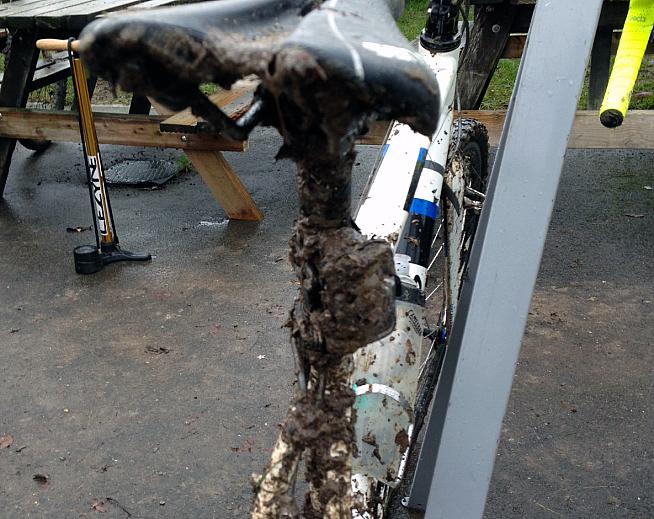The See.Sense is not your average bike light. It's a smart light, which does not mean it wears a bowtie and pomade quiff, but rather it contains sensors which interpret road conditions - your speed, orientation and ambient light including the headlights of approaching vehicles - and adjust the pattern and intensity of the light's beam accordingly.
It's a very smart idea. The See.Sense is the brainchild of Northern Irish electronic and software engineer Philip McAleese, who came up with the concept of a smarter bicycle light after being hospitalised in a cycling accident while commuting. He set up the company in 2012 together with his wife Irene and after successfully raising funding on Kickstarter See.Sense has gone from strength to strength, gathering numerous awards in the process.

So far so good, but how does it stand up in practice?
I've now been using the See.Sense rear light for over a month and it's performed very well. The light itself is compact and lightweight (62g) and the mounting mechanism is the simplest I've come across: simply turn it on, snap the rugged rubber strap around your seatpost, and off you go.
Charging is by USB using a cable provided. We like this, it means you can plug it into your computer when you arrive at work safe in the knowledge it'll be fully charged in time for your commute home.
One thing I was keen to find out is how long the light lasts on a single charge. A couple of hours is fine for commuting or a short spin, but what about cyclists taking on all-night bike rides like the Dunwich Dynamo?
We didn't get a chance to test this, but See.Sense claim the light will last for approximately 12 hours on a single charge, depending obviously on conditions as these will determine how brightly and often the light is shining in use. This should cover you for all-nighters, although for multi-day trips you'll need to remember to pack the USB charger.
Now to the nitty gritty and those smart features. Here we hit a minor snag when it comes to testing: as the rear light is sitting behind me, I can't actually see it do its thing while I'm riding. For all I know, the See.Sense could be signalling to oncoming drivers in Morse code to run me into a ditch (I didn't trust anyone enough to follow behind me in a car while I was cycling to check this). I'm inclined to take See.Sense at their word until proven otherwise, but if you're of a more sceptical nature there's a video on the See.Sense website that demonstrates it in action.
All joking aside, you can tell that the sensors are working simply by watching the light when you wheel it back into your house after a ride. To turn it off, you hold it face down for a few seconds (you'll need to remove it first, or pull a wheelie). To turn it on again, turn it from side to side three times.
When stationary - at traffic lights, say - the frenetic pulse of the flashes slows right down to mellow beats, and if you stay still too long the See.Sense gets bored and falls asleep. It's all very impressive, and I have noticed cars giving me plenty of space at night - although of course, I may just have encountered courteous drivers while testing.

One aspect of the See.Sense that may delight and frustrate in equal measure is that it has no buttons, knobs or switches to play with. All interaction is carried out via the sensors, and it even communicates with you by means of flashing lights. For example, the battery level is displayed when you first turn the light on by alternating flashes of a green indicator light with the main red light: the ratio of green to red indicates battery level, with more green flashes meaning more charge. You can also change settings including brightness and flash/constant beam by rotating the light in a variety of ways.
You may well ask yourself, does a light need to be that smart? Surely it is enough just to be bright?
I posed myself that very question when I first attempted to decipher the frenzied winking of my See.Sense. It's a bit like trying to talk to a dolphin, but with dazzling lights instead of clicks. I suspect some people will relish the cerebral workout, but personally I've taken to simply recharging my See.Sense after every ride and keeping the factory settings in order to avoid awkward attempts at conversation with the thing. Keep things simple and you can't go wrong.
Out on the roads, I guess if the See.Sense's varying light patterns increase my visibility to drivers even by just 10% then it's worth it.
One thing's for sure, in terms of pure brightness the See.Sense certainly packs a punch. The CREE LED on my mid-range model puts out 125 lumens spread over 180 degrees, ensuring a high degree of visibility for traffic approaching side-on as well as from behind. Two further models offering 95 lumens and 155 lumens are also available.
Given the amount of tech packed into the casing you'd hope the See.Sense is fairly robust - and so far it's held up admirably over some wet and muddy rides on both road and cyclocross bikes.
One thing worth noting: make sure the rubber seal for the USB port is properly closed before you set off. I made the mistake of leaving it slightly loose on my first ride with the See.Sense - the 100-mile Wiggle New Forest Sportive - and at the end discovered that some muddy water had made its way through the seal and into the light casing itself.
I thought I had probably broken the light, as there was a dusting of fine wet grit on the circuit board as well. But after prising open the casing (voiding my warranty) and wiping everything clean, to my relief it worked perfectly. I made sure to close the USB port properly the next time, and I've had no problem with any ingress of road muck since then - even on the Wiggle Fallen Leaves MTB sportive, when the See.Sense bore the brunt of the filthy conditions.

Downsides? Not much. Your mounting options are limited - it will only fit on the seatpost. And interpreting the bike's various signals - e.g. low battery - will take a while to learn. Priced at £54.99 for the 125 lumen version, the See.Sense is also at the higher end of the market in terms of pricing, but then it's a more complex product than most bike lights.
These are the merest quibbles for what is an excellent and genuinely innovative bike light. If you're looking for a light that is not only bright but bordering on sentient, then check out the See.Sense. It's available in a range of brightness options as front and rear lights or a set of two, and comes in attractive cardboard packaging with comprehensive instructions and enough sexy line diagrams to please even the geekiest of cyclists.
See.Sense - it's a smart light for smart cyclists. What's not to like?
See.Sense 2.0 Rear Light, from £44.99 at www.seesense.cc
0 Comments





